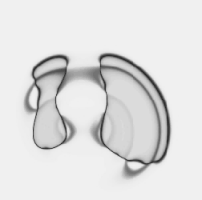
research interests
- optimal shape design
- pde-constrained optimization
- inverse problems
- computational mechanics
- mesh quality optimization
- variational image processing
advisor : omar ghattas

shape optimization
Level Set + Fictitious Domain + Robust Optimization = Fast Shape Optimization
In our PDE-constrained optimization approach for the shape optimization problem we employ a level set function to model the geometric domain of interest. The zero level set of this function defines the oriented boundary of the domain and its interior and exterior regions. With this representation, we compute the discrete solution of boundary value problems as follows: instead of building a mesh conforming to the boundary of the domain, we embed the level set function on a much simpler region which is then discretized using a regular grid of finite elements. The fictitious domain paradigm is applied to solve the boundary value problem (the forward problem) on this regular grid and enforce Dirichlet boundary conditions.
As for the nonlinear (inverse) shape optimization problem, we solve it using robust Newton-Krylov-based optimization algorithms in full space (all-at-once). Contrary to standard level set methods which propagate the interface by solving the Hamilton-Jacobi equation, we treat the shape evolution exclusively as an optimization problem. Neither signed distance functions nor level set reinitializations are required in our formulation. In fact, we believe reinitializations of the level set function are detrimental for gradient-based optimization algorithms. Experiments demonstrate that our iterative algorithms for shape optimization are fast and produce good solutions, requiring only a few nonlinear iterations.
Read an extended abstract about this work.
Check some results for model problems we have tested in one and two spatial dimensions.
We have also applied our variational optimization models to perform image segmentation. Thanks to Keith A. Johnson and J. Alex Becker of the Whole Brain Atlas for the MRI brain images we used in our tests.

mesh quality optimization
Mesh smoothing is a strategy used to improve the shape quality of mesh elements (triangles, quadrilaterals, tetrahedra, etc.) by repositioning its vertices. In its local version, smoothing consists of executing a sequence of optimal point placement calls, one for each vertex of the mesh. This is finding the point inside a star shaped polygon that maximizes the quality of the elements incident to that point. Although it is not clear, it seems the order in which these calls are made somehow influence the efficiency and the final outcome.
In this work, I am interested on developing and applying efficient nonsmooth optimization algorithms to solve the minimax formulation of the optimal point placement problem. Also of my interest is to validate long accepted heuristics via statistics experiments and drive conclusions as to when it is safe or not to apply them. The ultimate goal is to devise an efficient and optimal quality smoothing algorithm.
With today's guaranteed quality meshing algorithms, the impact of smoothing methods may not seem as remarkable as in the past, specially for planar triangular meshes. In 3D, it is still an attractive option to remove badly shaped elements, including slivers, a type of undesirable flat tetrahedron that algorithms persistently create at some point. One way or another, mesh generators benefit by employing some sort of post-generation improvement to enhance the final quality of the mesh they create. In practice, every commercial mesh generation package adheres to this concept.
Maybe the most urgent need of an efficient and robust smoothing algorithm is on problems that require dynamic, moving meshes. This is the case, for example, of simulations of fluid flow using the Lagrangian paradigm. There the fluid and mesh vertices flow with the same velocity and strongly skewed and inverted elements are inevitable to happen. To ensure a good quality mesh will always be available during the whole simulation, a mesh validation call is needed at each time step and repair is done from time to time. Such ideas have been implemented on a moving mesh strategy for triangular meshes where smoothing of mid-vertices on quadratic edges helped the creation of good quality, curved, Bézier meshes.
In summary, specific topics of interest are:
- efficient nonsmooth optimization algorithms for the optimal point placement problem; methods I am investigating include: smooth replacements for the max function - very attractive idea - exact penalty, log-barrier, active set methods
- strong upper bounds for star quality as a function of polytope quality (available tables coming soon)
- combining laplacian and optimization-based smoothing
- ordering on mesh smoothing
- fine matching between optimization methods and the quality metrics they optimize
- statistics evaluation of heuristics in smoothing methods
You might want to check:
- Moving mesh with curved elements
- Experimental upper bounds for star quality PDF
- Optimal smoothing in polygons PDF
Copyright Alexandre Cunha
updated on jul/2004